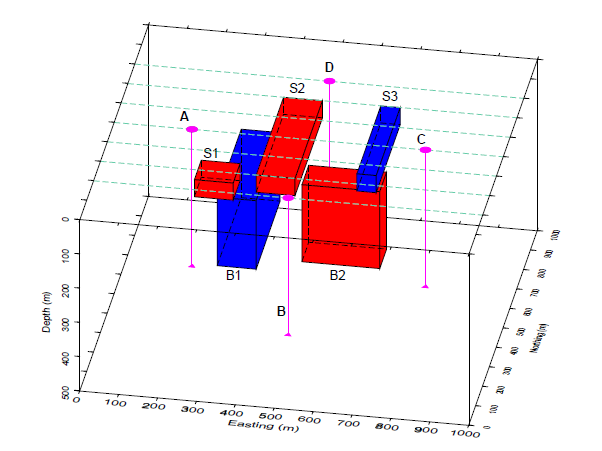Important
The 2014-10 release is compatible with GIFtools v2.30 and earlier. This version of the DCIPoctree package will not be maintained. For documentation of the latest version, see latest DCIP octree manual .
5. Example using five prisms¶
The example model is comprised of five anomalous rectangular prisms embedded in a uniform halfspace. There are three surface prisms simulating near-surface distortions, and two buried prisms simulating deeper targets, as shown in the figure below.

The five blocks are assigned conductivity and chargeability values, which are given in the table below.
DC resistivity and IP data are forward modelled for both surface and cross-borehole arrays using the DCIPoctreeFwd code. Three different electrode configurations were used for both DC and IP data types to show the benefits of a joint inversion using both surface and borehole data. Details of the three surveys are as follows:
Surface dataset: Pole-dipole arrays with a = 50 m (smallest potential electrode spacing) and n (potential electrode position) ranging from 1 to 6. Eleven east-west lines with a line spacing of 100 m were used to cover the core region of the model which is 1 square km. In total, 1089 observations were forward modelled using 209 current electrodes.
Borehole dataset: Pole-dipole arrays located within 4 boreholes, whose locations are specified in the table below. The data were simulated using a borehole array configuration in which the current electrode is moved down each of the 4 boreholes with 25 m steps to the depth of 350 m. This results in a total of 51 current electrode locations. For each of the current electrode locations, the potential electrode array, with a 50 m spread, was placed in each of the remaining three boreholes and moved down to a depth of 350 m at 25 m intervals, resulting in 1530 forward modelled observations.
Combined surface and borehole dataset: A combination of the above pole-dipole surface and borehole arrays, resulting in 260 current electrodes and 2619 total forward modelled observations.
Prior to inversion, 5% Gaussian noise was added to the forward modelled data, and uncertainties were assigned to be 5% of the data value plus a small floor.
The following pages describe the constant inversion parameters used and then the inversion of each dataset.